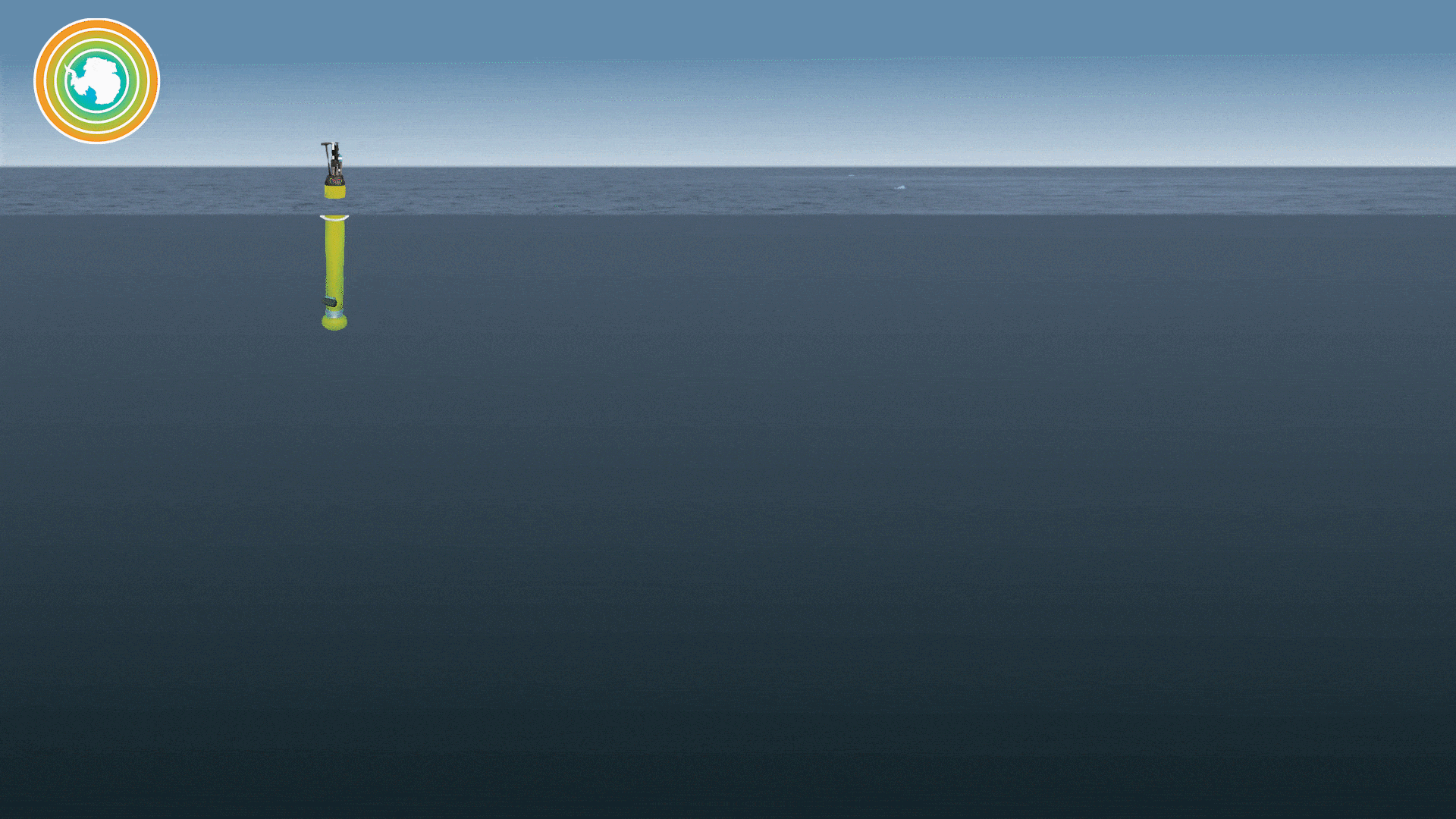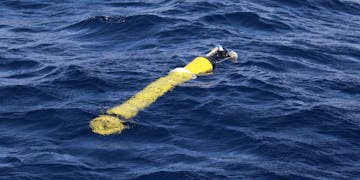Microscopic marine life plays a fundamental role in the ocean’s health and, ultimately, the planet. Just like plants on land, tiny phytoplankton use photosynthesis to consume carbon dioxide and convert it into organic matter and oxygen. This biological transformation is known as marine primary productivity. By converting carbon dioxide into organic matter, phytoplankton not only support oceanic food webs but are also the first step in the ocean’s biological carbon pump.
Marine primary productivity ebbs and flows in response to changes in our climate system. Monitoring primary productivity is crucial to understanding our changing climate, but observing the response on a global scale has been a significant problem.

MBARI Senior Scientist Ken Johnson and Research Specialist Mariana Bif have demonstrated how a fleet of robotic floats is revolutionizing our understanding of primary productivity in the ocean on a global scale. Data collected by these floats will allow scientists to more accurately estimate how carbon flows from the atmosphere to the ocean and shed new light on the global carbon cycle.
Phytoplankton consume carbon dioxide from the atmosphere and use it to build their bodies. Marine organisms eat those phytoplankton, die, and then sink to the deep seafloor. This organic carbon is gradually respired by bacteria into carbon dioxide. Since a lot of this happens at great depths, carbon is kept away from the atmosphere for long periods of time. This process sequesters carbon in deep-sea water masses and sediments and is a crucial component in modeling Earth’s climate now and in the future.
Directly measuring productivity in the ocean requires collecting and analyzing samples. Limitations in resources and human effort make direct observations at a global scale with seasonal to annual resolution challenging and cost-prohibitive. Instead, remote sensing by satellites or computer-generated circulation models offer the spatial and temporal resolution required, but neither of these are direct measurements.

Now, scientists have a new alternative for studying ocean productivity: thousands of autonomous Biogeochemical-Argo (BGC-Argo) floats drifting throughout the ocean.
These robots give scientists a glimpse at marine primary productivity across area, depth, and time. They are dramatically transforming our ability to estimate how much carbon the global ocean accumulates each year.
The BGC-Argo profiling floats measure temperature, salinity, oxygen, pH, chlorophyll, and nutrients. When scientists first deploy a BGC-Argo float, it sinks to 1,000 meters (3,300 feet) deep and drifts at this depth. Then, its autonomous programming gets to work profiling the water column. The float descends to 2,000 meters (6,600 feet), then ascends to the surface, gathering data along the way. Once at the surface, the float communicates with a satellite to send its data to scientists on shore. This cycle is then repeated every 10 days.
For the past decade, a growing fleet of BGC-Argo floats has been taking measurements across the global ocean. The floats capture thousands of profiles every year. This trove of data provided Johnson and Bif with scattered measurements of oxygen over time.
Knowing the pattern of oxygen production allowed the pair to compute net primary productivity at the global scale.
During photosynthesis, phytoplankton consume carbon dioxide and release oxygen at a certain ratio. By measuring how much oxygen phytoplankton release over time, researchers can estimate how much carbon they produce and how much carbon dioxide they consume. Oxygen goes up in the day when phytoplankton photosynthesize, then down at night when they respire. Although this is a well-known pattern, Johnson and Bif’s work represents the first time this daily cycle of oxygen has been quantitatively measured by instruments at the global scale rather than estimated through modeling and other tools.
But profiling floats only sample once every 10 days, and Johnson and Bif needed multiple measurements in one day to get a daily cycle. A novel approach to analyzing the float data allowed them to calculate ocean primary productivity. With each profiling float coming up at a different time of day, combining data from hundreds of floats and samples from various times of day allowed Johnson and Bif to recreate the daily cycle of oxygen going up and down and then calculate primary productivity.

A Biogeochemical-Argo (BGC-Argo) float collects data between the surface and 2,000 meters (6,600 feet) deep over 10 days. Image: Kim Fulton-Bennett © 2020 MBARI
To confirm the accuracy of the primary productivity estimates computed from the BGC-Argo floats, Johnson and Bif compared their float data to ship-based sampling data collected off Hawaii and Bermuda. The data acquired from the profiling floats near those regions gave similar results as monthly sampling from ships at these two sites over many years.
Johnson and Bif found that phytoplankton produced about 53 petagrams of carbon per year. This measurement was close to the 52 petagrams of carbon per year estimated by the most recent computer models. (One petagram is 1,000,000,000,000 kilograms, or one gigaton, and roughly the equivalent of the weight of 200 million elephants.) This study validated recent biogeochemical models and highlighted how robust these models have become.
Phytoplankton in the ocean consume carbon dioxide and convert it into organic matter and oxygen. This biological transformation is called marine primary productivity and is challenging to monitor globally. MBARI Senior Scientist Ken Johnson and Research Specialist Mariana Bif have demonstrated how a fleet of robotic floats can revolutionize our understanding of ocean primary productivity and, ultimately, ocean health. Video: © 2021 SOCCOM |
High-resolution data from the BGC-Argo floats help scientists better calibrate computer models that simulate productivity to ensure they represent real-world ocean conditions. These new data will also allow scientists to accurately predict how marine primary productivity will respond to changes in the ocean by simulating different scenarios such as warming temperatures, shifts in phytoplankton growth, ocean acidification, and changes in nutrients. As more floats are deployed, Johnson and Bif expect that the results of their study can be updated, decreasing uncertainties. Their work establishes a baseline from which scientists might detect future changes in productivity due to climate change.
But already, the wealth of data from these floats has proved invaluable in bettering our understanding of marine primary productivity and how Earth’s climate is linked to the ocean.
The BGC-Argo floats have been instrumental to the Southern Ocean Carbon and Climate Observations and Modeling (SOCCOM) project, an NSF-sponsored program focused on unlocking the mysteries of the Southern Ocean and determining its influence on climate. The Southern Ocean is one of the most remote places on the planet, yet it has a huge impact on Earth’s climate. SOCCOM leverages robotic technologies to monitor ocean health at all times of the year and in all kinds of conditions, aligning with MBARI’s vision for using technology innovations to better understand a changing ocean. SOCCOM floats incorporate technology developed by MBARI researchers. MBARI leads SOCCOM’s outreach efforts, including a program to bring live data from SOCCOM’s robotic floats to the classroom.
2020 marked the debut of the Global Ocean Biogeochemistry Array (GO-BGC Array) project, which will allow scientists to pursue fundamental questions about ocean ecosystems, observe ecosystem health and productivity, and monitor the elemental cycles of carbon, oxygen, and nitrogen in the global ocean through all seasons of the year.

The Chemical Sensors Group at MBARI—in conjunction with researchers from the University of Washington, Scripps Institution of Oceanography at the University of California, San Diego, Woods Hole Oceanographic Institution, and Princeton University—will build and deploy 500 robotic ocean-monitoring floats around the globe in the GO-BGC project. These floats will collect ocean chemistry and biology observations between the surface and a depth of 2,000 meters (6,600 feet).
Data streaming from the float array will be made freely available within a day of being collected, and will be used by scores of researchers, educators, and policy makers around the world. MBARI manages GO-BGC’s Adopt-A-Float Program, partnering with teachers and classrooms across the country to inspire and educate students about global ocean biogeochemistry and climate change. Both SOCCOM and GO-BGC create powerful opportunities for students of all ages to engage directly with world-class scientists and learn about ongoing research by naming and tracking BGC-Argo floats.
The information gathered by these collaborative global initiatives provides data essential to improving computer models of ocean fisheries and climate and monitoring, as well as forecasting the effects of ocean warming and ocean acidification on marine life.
